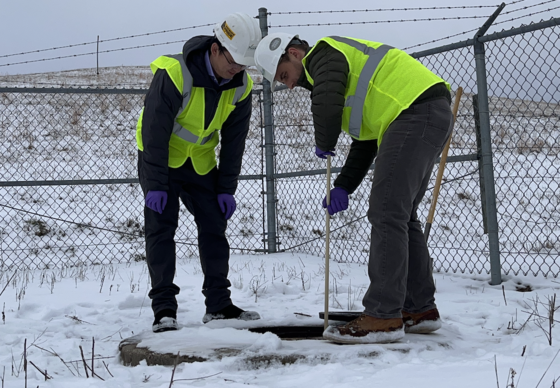Most Americans don’t think much about their trash once they’ve taken it outside of their home, which is a testament to our country’s efficient garbage management system.
Once that garbage truck rolls down the street, there’s a chance your trash is headed to one of the country’s roughly 3,000 operational landfills. And although it’s gone from your kitchen, the potential for that trash to then contaminate and harm people is something that must be carefully managed.
Kuo Tian, an assistant professor in the Sid and Reva Dewberry Department of Civil, Environmental, and Infrastructure Engineering at George Mason University, recently received a grant from the U.S. Department of Agriculture to look at solid waste management service in rural locations, focusing on the potential health threats to groundwater in those areas.
Modern landfills have a composite liner system to collect leachate, a liquid that starts as rainfall (or melted snow) and that pools at the bottom of the landfill after filtering through waste, pulling out chemicals and pollutants from the material. Leachate is held by a liner system, comprising a geomembrane—which is very resistant to puncture and is usually black in color because of carbon added for strength—on top of a layer of clay or geosynthetic clay liner, which serves as a containment redundancy. Small punctures in the membrane are inevitable, but leak detection techniques allow operators to examine the liner as it is put in place, identifying even tiny holes, which can be fixed before waste is layered on top.

Tian and his team will specifically examine the potential for PFAS leaking through the landfill liner system and contaminating nearby groundwater. PFAS—per- and polyfluorinated substances—are a group of chemicals used to make coatings for a variety of products and are commonly referred to as forever chemicals because they are persistent in the environment and in human bodies. Some evidence suggests they cause significant health problems.
The researchers will test both the types and concentrations of PFAS in leachate. “We want to assess the PFAS concentration over a year, looking at precipitation conditions, age of the landfill, and other factors,” Tian said.
The timing of the project is important, he says, because the EPA only recently created PFAS standards for drinking water, though there are currently no regulations to check PFAS concentrations in landfill leachates. Understanding how landfills may contribute to groundwater contamination will aid with landfill management moving forward.
According to Tian, a quality liner is critical. “A good liner will keep the leachate from migrating to the groundwater for hundreds or thousands of years.” So even if high PFAS levels are found, they may not pose an immediate risk. Further, he is concerned about PFAS migration to groundwater in older landfills, built prior to the early 1990s, which only use clay liners or in some cases lack liners entirely.
In addition to the research component, the grant contains funding for teaching elements. Once results from the research are confirmed, findings will be shared with local landfill operators and stakeholders.
In This Story
Related Stories
- April 22, 2024
- March 26, 2024
- March 5, 2024
- January 23, 2024
- January 22, 2024
